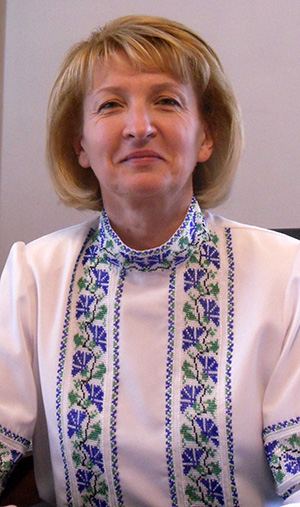|
 UDC 334.7:005.73; JEL M12, M14, M51, M54
UDC 334.7:005.73; JEL M12, M14, M51, M54
Lipych, L., Khilukha, O., Kushnir, M., & Volynets, I. (2022). Vplyv Khartiyi riznomanitnosti na formuvannya orhanizatsiynoyi kul'tury [The impact of the Diversity Charter on the corporate culture development]. In Sotsial'no-ekonomichni problemy suchasnoho periodu Ukrayiny [Socio-Economic Problems of the Modern Period of Ukraine]: Vol. 153 (1) (pp. 39-44). DOI: https://doi.org/10.36818/2071-4653-2022-1-6. [in Ukrainian].
Sources: 17
Authors
Lipych Lyubov HryhorivnaDoctor of Economics, Professor
Professor of the Department of entrepreneurship, trade and logistics of the Lutsk National Technical University
Contacts:  lglipych@gmail.com lglipych@gmail.com
Webpages:     

Khilukha Oksana AnatoliyivnaPh.D. of Economics, Associate Professor
Associate Professor of the Department of enterprise economics and information technologies of the Lviv University of Business and Law
Contacts:  oksаnа.hіluhа@vnu.еdu.uа oksаnа.hіluhа@vnu.еdu.uа
Webpages: 

Kushnir Myroslava AnatoliyivnaPh.D. of Economics, Associate Professor
Senior Lecturer of the Department of finance, banking and insurance of the Lesya Ukrainka Volyn National University; Senior Lecturer of the Department of applied economics and business of the Ukrainian Catholic University
Contacts:  mlipych@ukr.net mlipych@ukr.net
Webpages:  

Volynets Iryna HryhorivnaPh.D. of Economics, Associate Professor
Associate Professor of the Department of management and administration of the Lesya Ukrainka Volyn National University
Contacts:  irina.volynets@vnu.edu.ua irina.volynets@vnu.edu.ua
Webpages: 
ResumeThe Diversity Charter is a tool that allows adapting organizational culture to diversity and at the same time helps to create conditions for its development and management. The article aims to specify the benefits for the company from the use of the Diversity Charter and outline suggestions for changing the organizational culture on the basis of the Diversity Charter. The article argues that the organization has a culture that can be manipulated or managed as a strategic resource. Management that notices and values differences must adapt organizational culture to diversity. It means the need for planned evolutionary changes in organizational culture. The article shows that the concept of organizational culture of quality is a complement and, at the same time, the development of an integrated view of organizational culture. Quality culture is an organizational culture that has the ability to maintain a balance between openness (flexibility) of the system to various values contributed by its members and closedness (invariability) associated with the principles of quality management. The organizational culture is suggested to be changed by implementing the following principles of quality management (TQM): leadership, customer focus, continuous improvement, universal participation, and feedback analysis. After making appropriate adjustments, this procedure can be used for other strategic changes, including those aimed at adjusting the organizational culture for diversity. Diversity management is one of the key resources of the organization, which contributes to its development and achievement of business goals. Effective diversity management is a well-thought-out and well-implemented strategy. The procedure of changing the organizational culture on the basis of the Diversity Charter includes the following stages: focusing on diversity policy, determining the desired form of organizational culture in terms of its adaptation to diversity, diagnosing actual culture, analyzing discrepancies between postulated and diagnosed organizational culture, control over changes in organizational culture. The mechanism of realization of each stage is offered.
Keywords:Diversity Charter, effective diversity management, procedure of organizational culture change, concept of organizational quality culture, stages of organizational culture change
References- Lipych, L. H. (2021). Modeli orhanizatsiynoyi kul'tury pidpryyemstva v konteksti destruktyvnykh zmin [Models of organizational culture of the enterprise in the context of destructive changes]. Ekonomichnyy chasopys Volyns'koho natsional'noho universytetu imeni Lesi Ukrayinky – Economic Journal of Volyn National University named after Lesya Ukrainka, 2(27), 81-89. DOI: https://doi.org/10.29038/2786-4618-2021-0381-89 [in Ukrainian].
- Kopytko, M. I. (2016). Korporatyvna kul'tura pidpryyemstv: istoriya vynyknennya ta sutnist' [Corporate culture of enterprises: history and essence]. Prychornomors'ki ekonomichni studiyi – Black Sea Economic Studies, 9(1), С. 86-91. [in Ukrainian].
- Burlakova, A., & Savchuk, L. (2005). Rozvytok korporatyvnoyi kul'tury v Ukrayini [Development of corporate culture in Ukraine]. Personal – Personnel, 5, 86-89. [in Ukrainian].
- Schein, E. H. (1992). Organizational Culture and Leadership. San Francisco: Jossey-Bass Publishers.
- Chiocchio, F., Beaulieu, G., Bourdias, J. S., Rousseau, C., Aube, C., & Morin, E. M. (2010). The Project Involvement Index, psychological distress and psychological well-being: comparing workers from projectized and non-projectized organizations. International Journal of Project Management, 28(3), 201-211. DOI: https://doi.org/10.1016/j.ijproman.2009.05.007
- Griffith, D. A., & Harvey, M. G. (2001). Executive Insights: An Intercultural Communication Model for Usein Global Interorganizational Networks. Journal of International Marketing, 9(3), 87-103. DOI: https://doi.org/10.1509/jimk.9.3.87.19924
- Carpenter, M., Bauer, T., & Erdogan, B. (2012). Management Principles. Chapter 8. Organizational Culture. 2012books.lardbucket.org: Website. Retrieved from http://2012books.lardbucket.org/books/management-principles-v1.0/s12 organizational–culture
- Smircich, L. (1983). Concepts of Culture and Organizational Analysis. Administrative Science Quarterly, 28(3), 339-358. DOI: https://doi.org/10.2307/2392246
- Tipologiya korporativnykh kul’tur Ch. Khandi i osobennosti kadrovoy politiki dlya kazhdogo tipa [Typology of corporate cultures by Ch. Khandi and features of personnel policy for each type] (2012). In Z. V. Yakimova, V. I. Nikolayeva, Organizatsionnaya i korporativnaya kul'tura [Organizational and corporate culture]: Chrestomathy. Vladivostok: VGUES Publishing House, Sci-book.com: Website. Retrieved from https://sci-book.com/upravlenie-personalom/tipologiya-korporativnyih-kultur-handi-33684.html [in Russian].
- Lambert, T. (1999). Problemy zarządzania: 50 praktycznych modeli rozwiązań [Management problems: 50 practical solution models]. Warsaw: ABC Publishing House. [in Polish].
- Billing, Y. D., & Sundin, E. (2006). From managing equality to managing diversity: A critical Scandinavian perspective on genderand workplace diversity. In A. M. Konrad, P. Prasad, & J. K. Pringle (Eds.). Handbook of workplace diversity (pp. 95-119). DOI: https://doi.org/10.4135/9781848608092.n5
- Thomas, D. A. (2004). Diversity as Strategy. Harvard Business Review, 82(9), 98-108.
- Anand, R., & Winters, M. A. (2008). Retrospective View of Corporate Diversity Training from 1964 to the Present. Academy of Management Learning and Education, 7(3), 356-372. DOI: https://doi.org/10.5465/amle.2008.34251673
- Sznajder, A. (2013). Przewodnik po zarządzaniur óżnorodnością [A guide to managing diversity]. Warsaw: W&B. Retrieved from https://studylibpl.com/doc/1043160/przewodnik-po-zarz%C4%85dzaniu-r%C3%B3%C5%BCnorodno%C5%9Bci%C4%85 [in Polish].
- Wrench, J. (2007). Diversity Management and Discrimination. Aldershot: Ashgate Publishing Ltd.
- Kemper, L. E., Bader, A. K., Froese, F. J. (2016). Diversity Management in Ageing Societies: A Comparative Study of Germany and Japan. Management Revue, 27(1/2), 29-49. Retrieved from https://www.jstor.org/stable/24892942
- Poradnik szkoleniowy. Zarządzania różnorodnością [Training guide. Diversity management] (2007). International Society for Diversity Managament: Website. Retrieved from http://www.idm-diversity.org [in Polish].
|